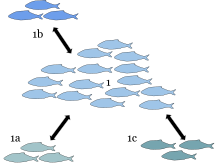
A metapopulation consists of a group of spatially separated populations of the same species which interact at some level. The term metapopulation was coined by Richard Levins in 1969 to describe a model of population dynamics of insect pests in agricultural fields, but the idea has been most broadly applied to species in naturally or artificially fragmented habitats. In Levins' own words, it consists of "a population of populations".[1]
A metapopulation is generally considered to consist of several distinct populations together with areas of suitable habitat which are currently unoccupied. In classical metapopulation theory, each population cycles in relative independence of the other populations and eventually goes extinct as a consequence of demographic stochasticity (fluctuations in population size due to random demographic events); the smaller the population, the more chances of inbreeding depression and prone to extinction.
Although individual populations have finite life-spans, the metapopulation as a whole is often stable because immigrants from one population (which may, for example, be experiencing a population boom) are likely to re-colonize habitat which has been left open by the extinction of another population. They may also emigrate to a small population and rescue that population from extinction (called the rescue effect). Such a rescue effect may occur because declining populations leave niche opportunities open to the "rescuers".
The development of metapopulation theory, in conjunction with the development of source–sink dynamics, emphasised the importance of connectivity between seemingly isolated populations. Although no single population may be able to guarantee the long-term survival of a given species, the combined effect of many populations may be able to do this.
Metapopulation theory was first developed for terrestrial ecosystems, and subsequently applied to the marine realm.[2] In fisheries science, the term "sub-population" is equivalent to the metapopulation science term "local population". Most marine examples are provided by relatively sedentary species occupying discrete patches of habitat, with both local recruitment and recruitment from other local populations in the larger metapopulation. Kritzer & Sale have argued against strict application of the metapopulation definitional criteria that extinction risks to local populations must be non-negligible.[2]: 32
Finnish biologist Ilkka Hanski of the University of Helsinki was an important contributor to metapopulation theory.
- ^ Levins, R. (1969), "Some demographic and genetic consequences of environmental heterogeneity for biological control", Bulletin of the Entomological Society of America, 15 (3): 237–240, doi:10.1093/besa/15.3.237
- ^ a b Kritzer, J. P. & Sale, P. F. (eds) (2006) Marine metapopulations, Academic Press, New York.